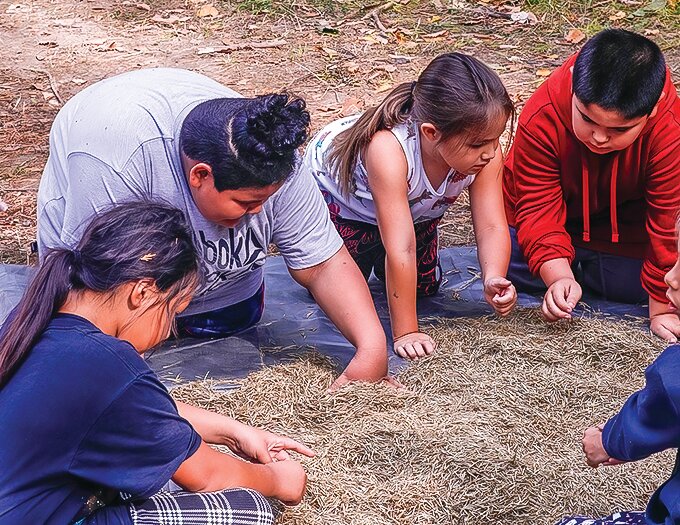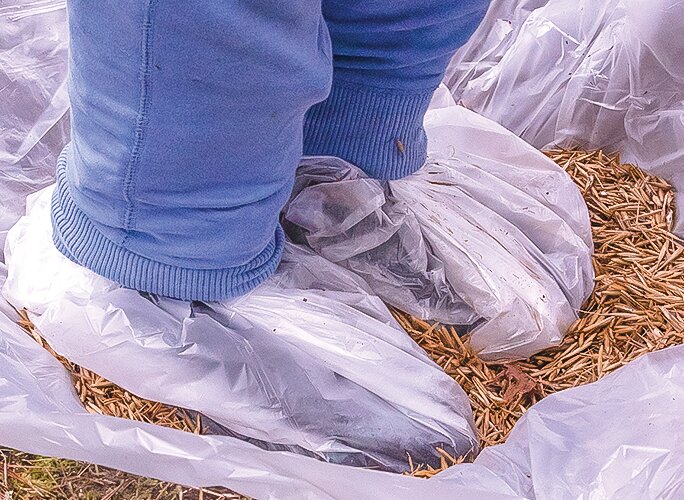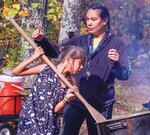Support the Timberjay by making a donation.
TRADITIONAL TEACHINGS
Wild rice camp links students to Ojibwe culture
NETT LAKE- The woods east of Nett Lake School were alive last week with the hoops and hollers of school children gleefully engaged while learning about an Ojibwe tradition, the processing of wild …
This item is available in full to subscribers.
Attention subscribers
To continue reading, you will need to either log in to your subscriber account, below, or purchase a new subscription.
Please log in to continue |
TRADITIONAL TEACHINGS
Wild rice camp links students to Ojibwe culture
NETT LAKE- The woods east of Nett Lake School were alive last week with the hoops and hollers of school children gleefully engaged while learning about an Ojibwe tradition, the processing of wild rice.
It’s the third year that Nett Lake School Ojibwe language and culture teacher Ryan Bajan has conducted wild rice camp for area school children, and last Friday the second and third graders of Nett Lake School were joined by sixth graders from North Woods School for the activities.
“We hold it all in a camp setting because traditionally these teachings happen in a camp setting where everyone is around,” Bajan said. “The expectations are that they get exposed to it, that they participate a little bit and get comfortable with that until they’re old enough to go ricing themselves. A lot of this teaching during the seasonal harvest is about food, sustenance, and how to provide for yourself and your family, and how to eat foods that are not just traditional but also better for our bodies.”
Last year, with ricing canceled on Nett Lake due to the poor condition of the wild rice, Bajan said they had to get by using some rice from the prior year’s harvest for camp, but this year the crop is plentiful, and campers had more than 300 pounds of rice to process.
Wild rice camp isn’t just a school event, it’s a community affair.
“I think we’ve had about 40 different families come throughout the week here, just stopping in and sharing stories, and then at our feasts we typically have about 100 people,” Bajan said. “We have really good families.”
Bajan also draws support from other community resources, such as Jennalee Porter with the Bois Forte nutrition program.
“She does classes with our school once a month,” Bajan said. “We partner with the Bois Forte conservation and forestry department for programming, and the 1854 Treaty program, and a new nonprofit teen program out of Tower.”
The wild rice camp is particularly important for its connection to Ojibwe history and culture.
“All Anishinaabeg, the only reason they live in the Great Lakes area is because of wild rice and the migration that took place beginning about a thousand years ago from the Northeast,” Bajan explained. “And here in particular at Asabiikone-zaaga`iganiing (Nett Lake) 400 years or so ago coming into this lake and seeing it look like a field when it was actually just in full bloom with manoomin, it was pretty unique, not just a major food source but also a major part of the economy. Even today for a lot of families it’s how they make a living.”
The learning process for camp also follows a traditional pattern, Bajan said.
“We try to have realistic expectations of our students,” he said. “They learn through observation first, and then they’re asked to participate. In almost all cases our students are leading a lot of our program behind the scenes, prepping things, bringing stuff together.”
The clearing in the woods where wild rice was being processed had clearly defined areas for each step. Tarps laid out on the ground provided a place for students to sift through the rice to remove impurities before parching. And rather than use a large flat pan that can hold up to 70 pounds of rice for parching, a more kid-friendly large metal kitchen pot set over an enclosed fire pit with a boat oar for stirring was a perfect setup for parching smaller, more easily managed loads of rice. And once the rice was parched, students could take the rice over to a separating station with a plastic-lined hole in the ground for the rice and a wooden frame to support a student’s weight as they used their clean plastic-covered feet to separate the bran outer layer from the kernels.
Wild rice camp isn’t only for Nett Lake School students, either. On Friday, 31 sixth-graders from North Woods School were there along with Indigenous Support Advocate Stacy Palmer to learn about wild rice and the steps in processing it.
“I just wanted to show off the Anishinaabe culture to the entire sixth grade class as it is part of their Minnesota history curriculum,” Palmer said.
Bajan said that the school shared the camp with around 100 students from other schools. But he had high praise for his own students who worked hard at camp the entire week.
“They’re highly engaged, I’d say more engaged than probably any student group I’ve ever worked with, and this is school number seven for me in 20 years of teaching,” he said.











